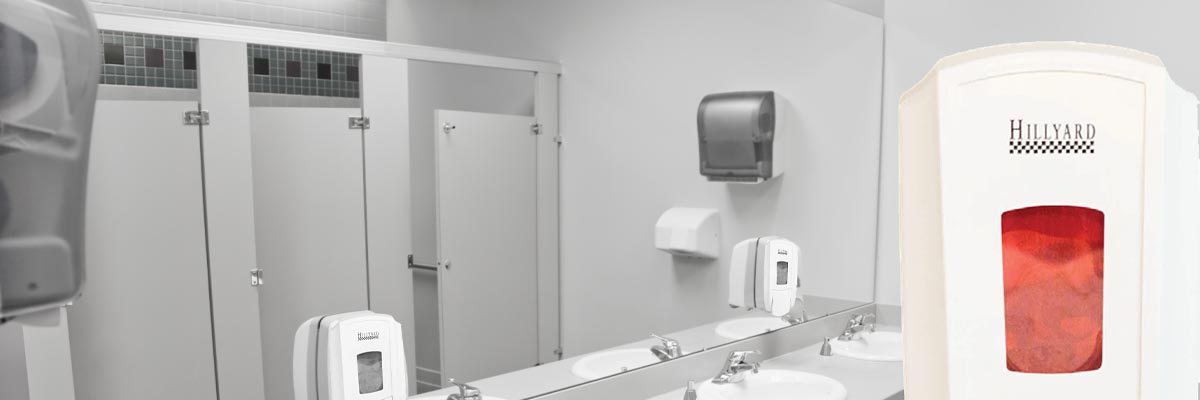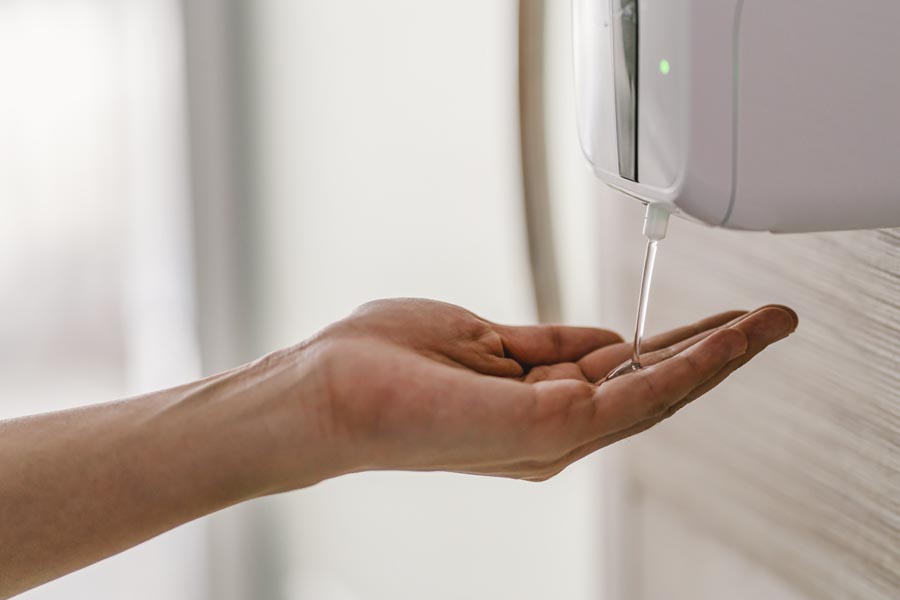Commercial Hand Soap Dispensers
Commercial liquid soap dispensers are essential hygiene tools used in offices, restaurants, healthcare facilities, and public restrooms. These dispensers are designed to provide a convenient and hygienic way for people to access soap and promote hand hygiene. This article will discuss the types of dispensers currently on the market and the key features you need to know to select the best option for your building.

Types of Hand Soap
Before we get into the particulars of commercial soap dispensers, let's cover the different types of hand soap you need to consider.
Regular, antibacterial, or antimicrobial
- Regular hand soap, for lack of a better term, doesn't fit into the other two categories mentioned in this section. Hand soaps help break down the dirt and oils on your skin. The lather formed by the soap then suspends the dirt and germs away from your skin until you wash them away with water.
- Antibacterial soaps function like regular hand soap and include chemicals to reduce or prevent bacterial infection.
- Antimicrobial soaps function like regular hand soap but include chemicals to kill or stop the growth of microorganisms. These products protect against a broader spectrum of microbes than antibacterial products. Antimicrobial soaps protect against bacteria, mold, fungi, and viruses.
Moisturizing vs. regular
- Frequent hand washing can dry out skin, leaving it prone to cracking. In more severe cases, dry skin can lead to breaks in the skin, allowing microbes to slip past this protective barrier. To help counteract this problem, some products include a moisturizer that can be absorbed into your skin, replenishing the oils to prevent over-drying.
Scented or unscented
- Some products include fragrance oils that impart a lasting scent after you rinse your hands. The fragrance itself has no impact on the effectiveness of the product. The scent you select is primarily a matter of personal preference.
Liquid or foaming
- Liquid hand soap is the most commonly used form. With its relatively high viscosity, it is easy to dispense.
- Foam dispensers infuse the soap with air, creating a light, foamy texture. With a lighter texture, foamed hand soap is easier to work up a lather. Because it has a larger volume, people use less when washing their hands.
Powder vs. liquid
- Powder hand soap is generally found in industrial environments like machine shops or factories. These heavy-duty cleaners often include abrasives, like pumice, to cut through grease and tough soils.
- Liquid hand soap is far more common in non-industrial commercial applications than its powdered counterpart. Many manufacturers offer products that are also suitable for heavy-duty industrial applications.

Features of Commercial Dispensers
Commercial dispensers are available with a variety of features. The list below itemizes these features so you can decide what would be best for your facility.
Mounting Method
Commercial dispensers will either be mounted with an adhesive or with a system of wall anchors.
- Wall-Mounted Soap Dispensers. Wall anchor mounting is more reliable than mounting with an adhesive. Sturdy wall anchors will stand up better for repeated use in a high-volume commercial environment. Also, if the dispenser needs to be replaced, you might be able to replace it easily by reusing the wall anchors. This method requires drilling holes in the walls, which may not be possible in every situation.
- Adhesive-Mounted Soap Dispensers. Adhesive-backed "no-drill" mounting, while less reliable, is sometimes the best choice. If you need to place a commercial soap dispenser on glass, a mirror, or tile, where drilling isn't possible, adhesives are the only choice. It is simple to install a commercial soap dispenser with adhesives. Clean the surface well first, then follow the manufacturer's instructions to mount the dispenser. Replacing the dispenser will be more difficult, however, because you must remove the adhesive pad from the wall before installing the new dispenser.
Dispenser Capacity
Liquid soap dispenser capacity is important because it will dictate how often you need custodians to service it. Dispenser capacity will generally range from 800ml (27 oz) to 2000ml (67 oz), with the most common sizes being between 1,000ml and 1200ml. In addition to the overall capacity, you should consider how many uses, or strokes, the dispenser will provide before it is empty.
Hillyard offers two different sizes in the Affinity line of hand hygiene products.
Affinity manual dispensers have 1,250ml refills, providing 1,250 uses for liquid soap and up to 3,125 uses for foaming soap.
Affinity automatic dispensers have 1,000ml refills, providing 1,000 uses for liquid soap and up to 2,500 uses for foaming soap.
Automatic Soap Dispensers or Manual Soap Dispensers
Liquid soap dispensers can either be automatic, i.e. operated with a motion sensor, or manual pump type.
Manual Pump Dispensers: Pros and Cons
- People are more likely to use the dispenser twice, increasing soap consumption per user.
- Because people need to touch the dispenser, it increases the possibility of microbe transference from the surface of the dispenser to the hands.
- Some users may use excessive force on the dispenser, increasing the chance of breaking prematurely.
- Does not require batteries, eliminating the need for custodians to have access to batteries.
Automatic Pump Dispensers: Pros and Cons
- Automatic or touchless soap dispensers use batteries to power the sensor and pump. You will need to make sure you have a supply of batteries in your supply closet.
- Because they are touchless, automatic soap dispensers are more hygienic than their manual counterparts. Also, your dispensers won't have the same wear-and-tear due to misuse as manual dispensers.
- Because automatic soap dispensers are delayed between dispenses; users will move on to washing their hands without waiting for a second serving.
Bulk or Cartridge Soap Refills
Commercial dispensers come in one of two varieties, refillable and sealed cartridge systems.
Bulk refillable dispensers have been around for decades. They offer one primary advantage, lower refill cost, but several negative factors must be considered.
- Time and mess. Refilling a manual dispenser is slow and can lead to wasting soap through spilling. In addition, after a spill, your custodian has to spend time cleaning up around the dispenser rather than moving to another task.
- Risk of contamination. When a refillable dispenser is serviced, germs can be introduced into the tank. Studies show this can increase the spread of germs. A 2002 study
by the CDC recommends not "topping off" dispensers to reduce the risk of bacterial contamination. Additionally, 2009 guidelines
from the WHO recommend using disposable reservoir dispensers over refillable dispensers. They also recommend cleaning and disinfecting refillable dispensers during servicing.
- Vandalism. Since restrooms are often targets of vandalism, contamination of refillable containers is a genuine concern.
- Maintaining nozzles is difficult. The nozzles in refillable dispensers are a common fail point. When the nozzle becomes clogged, users can no longer get soap to wash their hands, reducing overall hygiene and decreasing the image of your facility. Repairing and replacing clogged nozzles is a nuisance that can be eliminated with a sealed cartridge dispenser.
A cartridge dispensing system, like Hillyard's Affinity Skin Care
line, mitigates many of these problems.
- Sealed containers are quickly and cleanly placed inside the dispenser. The entire process is faster and cleaner.
- There is no risk of contamination.
- Because the nozzle is integrated into the refill cartridge, it is replaced with each refill. Less risk of clogging
- Many dispensers feature a large sight window, allowing custodians to view soap levels.
- Additionally, Hillyard Affinity uses a thin, durable molded PET bottle, which uses up to 50% less plastic than other cartridge refill systems.
Commercial Soap Dispensers from Hillyard
Hillyard's Affinity line is a best-in-class solution for soap dispensing. The Affinity line is a sealed system with both manual and automatic dispensers. This system includes products beyond just hand hygiene. Affinity Hair and Body Wash, and hand sanitizer are also available. Your local Hillyard representative can meet with you to assess your current operation and recommend changes to improve hand hygiene in your facility. Use the "I'm Interested" form below, and one of our representatives will contact you.
Frequently Asked Questions
What are the types of soap dispensers?
Many different types of soap dispensers are available on the market, each designed to meet different needs and styles. Manual soap dispensers are simple hand-pumped units. Automatic soap dispensers us a motion sensor and a pump to dispense soap. Both types are available in liquid and foaming soap models.
How do you refill a commercial hand soap dispenser?
Refilling a commercial hand soap dispenser depends on the dispenser you use. Simply remove the pump or nozzle and add your desired soap to the reservoir for manual units. You may need to open the unit and refill it with a cartridge or bottle of soap for automatic dispensers. Your user manual will provide more specific instructions for your particular model.
Are automatic soap dispensers worth it?
Most people prefer automatic soap dispensers because they are touchless and more hygienic. Building owners also prefer automatic soap dispensers because they include delays between uses that stop users from taking too much soap at once.
What is an ADA-compliant soap dispenser?
The ADA requires that soap dispensers be operated with a single closed fist or an open hand rather than a tight grasp or twisting the wrist. The dispenser can not protrude more than four inches from the wall. In addition, the ADA requires that the dispenser's highest operable part be no more than 48 inches off the floor. If the dispenser is placed over a sink, the sink must not protrude more than 20 inches. Sinks that protrude more between 20 and 25 inches require that the dispenser be mounted no higher than 44 inches from the floor if mounted above.